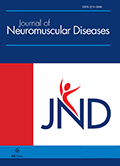Authors: Rodrigues, Merryl | Echigoya, Yusuke | Fukada, So-ichiro | Yokota, Toshifumi
Article Type:
Review Article
Abstract:
Duchenne muscular dystrophy (DMD) is an X-linked genetic disorder characterized by progressive muscle degeneration. Mutations in the DMD gene result in the absence of dystrophin, a protein required for muscle strength and stability. Currently, there is no cure for DMD. Since murine models are relatively easy to genetically manipulate, cost effective, and easily reproducible due to their short generation time, they have helped to elucidate the pathobiology of dystrophin deficiency and to assess therapies for treating DMD. Recently, several murine models have been developed by our group and others to be more representative of the human DMD mutation
…types and phenotypes. For instance, mdx mice on a DBA/2 genetic background, developed by Fukada et al., have lower regenerative capacity and exhibit very severe phenotype. Cmah -deficient mdx mice display an accelerated disease onset and severe cardiac phenotype due to differences in glycosylation between humans and mice. Other novel murine models include mdx52 , which harbors a deletion mutation in exon 52, a hot spot region in humans, and dystrophin/utrophin double-deficient (dko ), which displays a severe dystrophic phenotype due the absence of utrophin, a dystrophin homolog. This paper reviews the pathological manifestations and recent therapeutic developments in murine models of DMD such as standard mdx (C57BL/10), mdx on C57BL/6 background (C57BL/6-mdx ), mdx52 , dystrophin/utrophin double-deficient (dko ), mdx β geo , Dmd-null , humanized DMD (hDMD ), mdx on DBA/2 background (DBA/2-mdx ), Cmah-mdx , and mdx/mTRKO murine models.
Show more
Keywords: Duchenne muscular dystrophy (DMD), exon skipping, mdx, mdx52, hDMD, dko, C57BL/6-mdx, DBA/2-mdx, Cmah-mdx, Dmd-null
DOI: 10.3233/JND-150113
Citation: Journal of Neuromuscular Diseases,
vol. 3, no. 1, pp. 29-48, 2016





